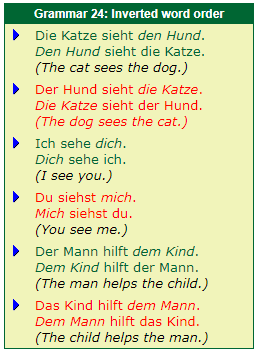General word order
It is not only adverbs however which can be placed at the start of a German clause. You may have noticed that - unlike in English - it is also possible to emphasise an accusative or dative object by putting it at the start of a sentence. This is because in German, it is the the case endings, not the word order, which tell us who is doing what to whom, i.e. what is the subject and what are the objects.
Thus the following pairs of sentences have the same basic meaning, even though the subject of the clause is in first position only in the first sentence in each pair. Note how the case endings change depending on who is doing what to whom!

Notes
Point 1In each of these pairs there is a slight difference in that the first element in each sentence is always being stressed. wheras the first sentence in each pair stresses therefore who is performing the action i.e. seeing or helping, the second sentence stresses more who is being seen or being helped.
Point 2Certain nouns, pronouns, definite and indefinite articles have identical endings in the nominative and accusative cases. In most instances, common sense will tell you who is performing the action. For example, in the clause "Bier darf Thomas nicht trinken", it should hopefully be clear that it is Thomas who not allowed to drink beer and not vice versa.
Yet the phrase "sie sieht sie" could have six different meanings:
1) "she sees her"; 2) "she sees them"; 3) "she sees it (= feminine noun)"; 4) "it sees her"; 5) "it sees them"; 6) "it sees it"!  英语
英语 日语
日语 韩语
韩语 法语
法语 西班牙语
西班牙语 意大利语
意大利语 阿拉伯语
阿拉伯语 葡萄牙语
葡萄牙语 越南语
越南语 俄语
俄语 芬兰语
芬兰语 泰语
泰语 丹麦语
丹麦语 对外汉语
对外汉语

